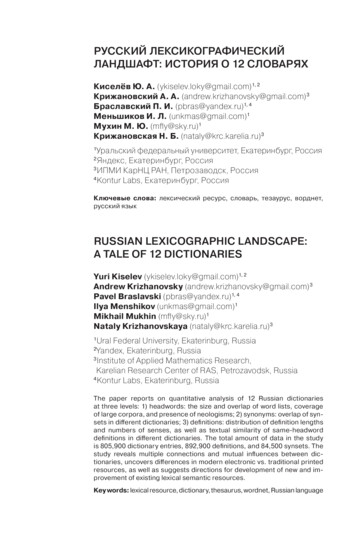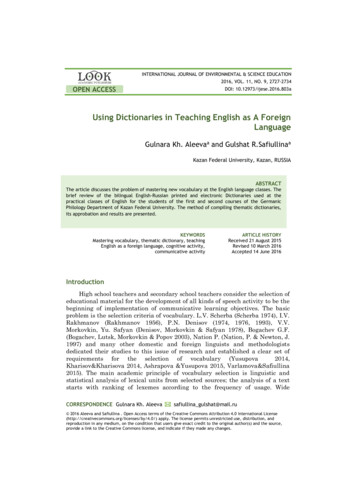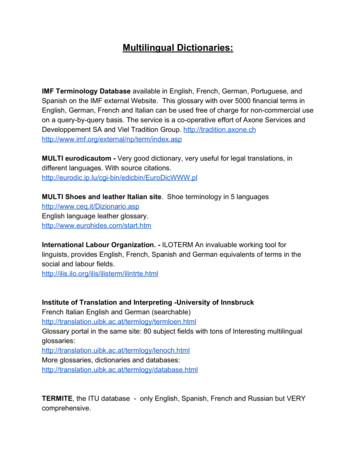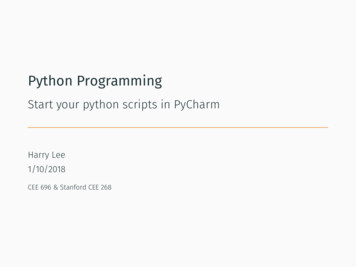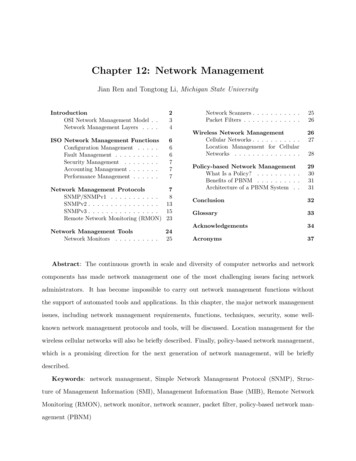
Transcription
Python DictionariesChapter 9Python for Informatics: Exploring Informationwww.pythonlearn.com
Unless otherwise noted, the content of this course material is licensed under a CreativeCommons Attribution 3.0 /.Copyright 2010- Charles Severance
What is a Collection? A collection is nice because we can put more than one value in themand carry them all around in one convenient package. We have a bunch of values in a single “variable”We do this by having more than one place “in” the variable.We have ways of finding the different places in the variable
What is not a “Collection” Most of our variables have one value in them - when we put a newvalue in the variable - the old value is over written pythonPython 2.5.2 (r252:60911, Feb 22 2008, 07:57:53)[GCC 4.0.1 (Apple Computer, Inc. build 5363)] on darwin x 2 x 4 print x4
A Story of Two Collections. List A linear collection of values that stay in orderDictionary A “bag” of values, each with its own label
//en.wikipedia.org/wiki/Associative array
Dictionaries Dictionaries are Python’s most powerful data collectionDictionaries allow us to do fast database-like operations in PythonDictionaries have different names in different languages Associative Arrays - Perl / PhpProperties or Map or HashMap - JavaProperty Bag - C# / .Nethttp://en.wikipedia.org/wiki/Associative array
Dictionaries Lists index their entriesbased on the position in thelist Dictionaries are like bags no order So we index the things weput in the dictionary with a“lookup tag” purse dict() purse['money'] 12 purse['candy'] 3 purse['tissues'] 75 print purse{'money': 12, 'tissues': 75, 'candy': 3} print purse['candy']3 purse['candy'] purse['candy'] 2 print purse{'money': 12, 'tissues': 75, 'candy': 5}
purse dict() purse['money'] 12 purse['candy'] 3 purse['tissues'] 75moneycandytissues12375 print purse{'money': 12, 'tissues': 75, 'candy': 3}candy print purse['candy']3 purse['candy'] purse['candy'] 2 print purse{'money': 12, 'tissues': 75, 'candy': 5}5
Comparing Lists and Dictionaries Dictionaries are like Lists except that they use keys instead ofnumbers to look up values lst list() lst.append(21) lst.append(183) print lst[21, 183] lst[0] 23 print lst[23, 183] ddd dict() ddd['age'] 21 ddd['course'] 182 print ddd{'course': 182, 'age': 21} ddd['age'] 23 print ddd{'course': 182, 'age': 23}
lst list() lst.append(21) lst.append(183) print lst[21, 183] lst[0] 2323 print lst[23, 183] ddd dict() ddd['age'] 21 ddd['course'] 182 print ddd{'course': 182, 'age': 21} ddd['age'] 2323 print ddd{'course': 182, 'age': 23}ListKeyValue[0] 21[1] 183lllDictionaryKeyValue[course] 183[age] 21ddd
Dictionary Literals (Constants) Dictionary literals use curly braces and have a list of key : value pairsYou can make an empty dictionary using empty curly braces jjj { 'chuck' : 1 , 'fred' : 42, 'jan': 100} print jjj{'jan': 100, 'chuck': 1, 'fred': 42} ooo { } print ooo{}
Most Common Name?cwenzhen zhen marquardcsevzhencsevmarquardmarquardcsev cwenzhenzhen
Most Common Name?
Most Common Name?cwenzhen zhen marquardcsevzhencsevmarquardmarquardcsev cwenzhenzhen
Many Counters with a Dictionary One common use of dictionary iscounting how often we “see” something ccc dict() ccc['csev'] 1 ccc['cwen'] 1 print ccc{'csev': 1, 'cwen': 1} ccc['cwen'] ccc['cwen'] 1 print ccc{'csev': 1, 'cwen': 2}KeyValue
Dictionary Tracebacks It is an error to reference a key which is not in the dictionaryWe can use the in operator to see if a key is in the dictionary ccc dict() print ccc['csev']Traceback (most recent call last):File " stdin ", line 1, in module KeyError: 'csev' print 'csev' in cccFalse
When we see a new name When we encounter a new name, we need to add a new entry in thedictionary and if this the second or later time we have seen the name,we simply add one to the count in the dictionary under that namecounts dict()names ['csev', 'cwen', 'csev', 'zqian', 'cwen']for name in names :if name not in counts:counts[name] 1else :counts[name] counts[name] 1{'csev': 2, 'zqian': 1, 'cwen': 2}print counts
The get method for dictionary This pattern of checking tosee if a key is already in adictionary and assuming adefault value if the key is notthere is so common, thatthere is a method called get()that does this for usDefault value if key does notexist (and no Traceback).if name in counts:print counts[name]else :print 0print counts.get(name, 0){'csev': 2, 'zqian': 1, 'cwen': 2}
Simplified counting with get() We can use get() and provide a default value of zero when the key isnot yet in the dictionary - and then just add onecounts dict()names ['csev', 'cwen', 'csev', 'zqian', 'cwen']for name in names :counts[name] counts.get(name, 0) 1print countsDefault{'csev': 2, 'zqian': 1, 'cwen': 2}
Writing programs (or programming) is a very creative and rewarding activity. You canwrite programs for many reasons ranging from making your living to solving a difficultdata analysis problem to having fun to helping someone else solve a problem. Thisbook assumes that everyone needs to know how to program and that once you knowhow to program, you will figure out what you want to do with your newfound skills.We are surrounded in our daily lives with computers ranging from laptops to cellphones. We can think of these computers as our personal assistants'' who can takecare of many things on our behalf. The hardware in our current-day computers isessentially built to continuously ask us the question, What would you like me to donext?''.Our computers are fast and have vasts amounts of memory and could be very helpfulto us if we only knew the language to speak to explain to the computer what wewould like it to do next''. If we knew this language we could tell the computer to dotasks on our behalf that were reptitive. Interestingly, the kinds of things computers cando best are often the kinds of things that we humans find boring and mind-numbing.
the clown ran after the car and the car ran into the tent and thetent fell down on the clown and the car
Counting Patterncounts dict()print 'Enter a line of text:'line raw input('')words line.split()print 'Words:', wordsThe general pattern to count thewords in a line of text is to splitthe line into words, then loopthrugh the words and use adictionary to track the count ofeach word independently.print 'Counting.'for word in words:counts[word] counts.get(word,0) 1print 'Counts', counts
Counting Wordspython wordcount.pyEnter a line of text:the clown ran after the car and the car ran into the tentand the tent fell down on the clown and the carWords: ['the', 'clown', 'ran', 'after', 'the', 'car', 'and', 'the','car', 'ran', 'into', 'the', 'tent', 'and', 'the', 'tent', 'fell', 'down','on', 'the', 'clown', 'and', 'the', 'car']Counting.Counts {'and': 3, 'on': 1, 'ran': 2, 'car': 3, 'into': 1, 'after': 1,'clown': 2, 'down': 1, 'fell': 1, 'the': 7, 'tent': 7974/
counts dict()print 'Enter a line of text:'line raw input('')words line.split()print 'Words:', wordsprint 'Counting.'for word in words:counts[word] counts.get(word,0) 1print 'Counts', countspython wordcount.pyEnter a line of text:the clown ran after the car and the carran into the tent and the tent fell downon the clown and the carWords: ['the', 'clown', 'ran', 'after', 'the','car', 'and', 'the', 'car', 'ran', 'into', 'the','tent', 'and', 'the', 'tent', 'fell', 'down', 'on','the', 'clown', 'and', 'the', 'car']Counting.Counts {'and': 3, 'on': 1, 'ran': 2, 'car': 3,'into': 1, 'after': 1, 'clown': 2, 'down': 1,'fell': 1, 'the': 7, 'tent': 2}
Definite Loops and Dictionaries Even though dictionaries are not stored in order, we can write a forloop that goes through all the entries in a dictionary - actually it goesthrough all of the keys in the dictionary and looks up the values counts { 'chuck' : 1 , 'fred' : 42, 'jan': 100} for key in counts:.print key, counts[key].jan 100chuck 1fred 42
Retrieving lists of Keys and Values You can get a list of keys,values or items (both) from adictionary jjj { 'chuck' : 1 , 'fred' : 42, 'jan': 100} print list(jjj)['jan', 'chuck', 'fred'] print jjj.keys()['jan', 'chuck', 'fred'] print jjj.values()[100, 1, 42] print jjj.items()[('jan', 100), ('chuck', 1), ('fred', 42)] What is a 'tuple'? - coming soon.
Bonus: Two Iteration Variables! We loop through thekey-value pairs in adictionary using *two*iteration variables Each iteration, the firstvariable is the key andthe the second variable isthe corresponding valuefor the key jjj { 'chuck' : 1 , 'fred' : 42, 'jan': 100} for aaa,bbb in jjj.items() :.print aaa, bbb.jan 100aaa bbbchuck 1fred 42[jan] 100 [chuck] 1[fred] 42
name raw input("Enter file:")handle open(name, 'r')text handle.read()words text.split()counts dict()for word in words:counts[word] counts.get(word,0) 1bigcount Nonebigword Nonefor word,count in counts.items():if bigcount is None or count bigcount:bigword wordbigcount countprint bigword, bigcountpython words.pyEnter file: words.txtto 16python words.pyEnter file: clown.txtthe 7Dictionaries
Summary What is a collection? Lists versus Dictionaries Dictionary constants The most common word Using the get() method Hashing, and lack oforder Writing dictionary loops Sneak peek: tuples Sorting dictionaries
Python Dictionaries Chapter 9 Python f

